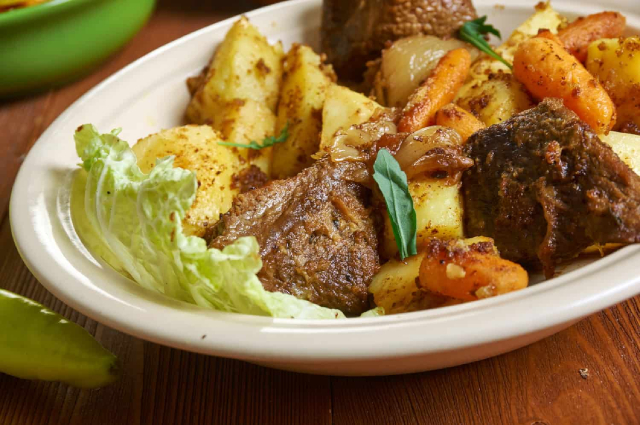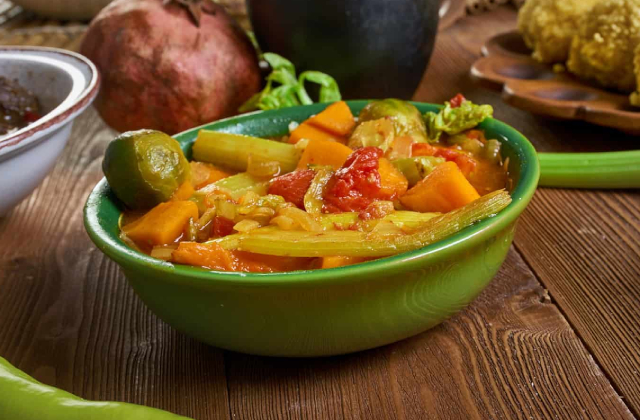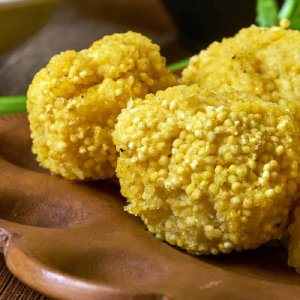With one foot in the desert and the other in the bounteous waters of Africa’s second-largest fresh water lake, Chad has a unique place in African culture. That is, it is home to a unique collection of donor cultures and native ingredients that add up to a unique national cuisine featuring one of the widest varieties of dishes we’ve seen yet in our travels…
 Jarret de Boeuf: A tasty relic of the French administration that ruled Chad
Jarret de Boeuf: A tasty relic of the French administration that ruled Chad
from 1920 to 1960. Essentially a traditional dish that became popular
with the French colonialists, and picked up a few French nuances.
Chad is a landlocked Central African nation with unique resources and a chequered history blending several contrasting cultural influences. The Tuareg and Arab people of the north are vastly different in their languages, religion and eating habits from the peoples of the south, who were much more heavily influenced by their agricultural traditions and a period of French occupation that left lasting marks.
According to Wikipedia, Chad spans no fewer than four distinct climatic zones: “Chad has several regions: a desert zone in the north, an arid Sahelian belt in the centre and a more fertile Sudanian Savanna zone in the south. Lake Chad, after which the country is named, is the second-largest wetland in Africa.”
That’s a lot of ground to cover, so let’s get the show on the road!
On our menu today…
As we’ll see, the Chadians of the north have traditionally relied on herding for their sustenance. That means a lot of meats and stews, and dairy ingredients showing up in many dishes. In the south, where conventi0onaol agriculture is more prevalent, and the French influence is still strong, we see a lot more vegetables and a greater variety of ingredients in dishes. Grains, such as millet and sorghum, are a key part of the overall Chadian diet.
Kisra: This is the ubiquitous flatbread of Chad, usually made of sorghum flour. It’s usually found as a starch accompaniment to moulah, a traditional stew. Kisra can also be stuffed or filled. It’s everywhere.
Aiyash: These are balls or croquettes of deep-fried millet paste which fill the role of ‘dumpling’ in Chadian cuisine (see photo, top of page). They are just about as ubiquitous as kisra and are usually served with dishes that provide a savoury sauce or broth to lend them flavour. Sometimes a traditional peanut butter sauce is provided.
La Bouillie: Breakfast in Chad is often La Bouillie, a porridge made of whole grain wheat or rice. As such, it resembles Rice Puddings found in other cuisines. Whatever the grain base, it’s cooked in milk and thickened with flour. The grains’ natural sugars are relied on to sweeten the mix. Freshly prepared, home-made peanut butter is often added for flavour.
Jarret de Boeuf: Here’s an example of the influence that still lingers from the French administration that ruled Chad from 1920 to 1960. It’s a stew featuring ‘shin of beef’ and vegetables commonly grown in the southern part of Chad. The main flavours of the Stew’s brothy (or sauce) come from tomatoes, onion, crushed garlic and coriander. Carrots, leeks, and potatoes may added after the meat has simmered most of the way to fall-apart tenderness, so that they cook through and take on the flavour of the sauce but don’t go mushy.
Daraba: This is a common vegetable stew that relies on the flavour of peanuts for its unique character. Ground peanuts are added to the dish as it simmers, and whole peanuts may be sprinkled on top before before serving.

One of the main ingredients of Daraba is okra, often accompanied by tomatoes, sweet potatoes, aubergine (eggplant), and leafy greens such as spinach. (Spinach turns up over and over again as a supporting actor in Chadian cuisine.)
Bangaou: This is the northern Chadian counterpart to Daraba; predominantly composed of meat where Daraba is mainly vegetables. It’s usually based on lamb, bite-sized pieces of which are first seared in hot oil. Water is then added, along with a bouillion cube (not, I presume, a ‘traditional’ touch) plus chilis and beans – peas, chickpeas or beans.
Capitaine: This is the ‘charter ingredient’ in a whole class of Chadian dining: Also known as Nile Perch and giwun ruwa (‘water elephant’, in Hausa), this fish is enjoyed in a plethora of ways. It is the main ‘product’ of Lake Chad, and has been part of the diet in southern Chad since humans first arrived there thousands of years ago. Capitain is commonly dried as whole fish or fillets, but is also eaten fresh, marinated in oil and chilis and grilled – or deep fried whole, which gives it a crispy crust.
Endless variety…
What with the variety of contributing cultures and influences, and the whole range of native ingredients found in the country, we should not be surprised that there’s a whole ‘nother world of cuisine still to be explored in Chad! And the internet is the place to discover it – if you can’t go there yourself. However you introduce yourself to the food of Chad, do it today!
~ Maggie J.

